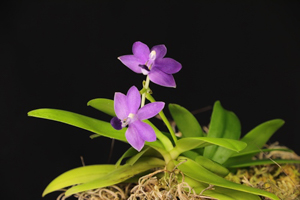Growing Orchids: October in St. Augustine
If you like what you see, feel free to leave a donation; just click on the Tip Jar. Thank you!Based on AOS monthly checklists by Robert Scully and Ned Nash & James Rose, adapted to St. Augustine by local growers

General Orchid Growing Tips
We usually receive our first cold snap around Halloween, so if you are growing outdoors, this is the time for you to make your winter preparations. Check your winter structure, test fire your heaters and start cleaning your plants. The shortening day length and cooler nights initiate all sorts of changes in your orchids. Your plants require less water and fertilizer now. Observe the rate at which your plants dry out after watering and make adjustments, gradually adding days in between your normally watering cycle. Consider removing shading from the greenhouse to allow more light during the winter months.

Cattleyas
Many fall blooming cattleyas are getting ready to bloom and buds are swelling in their sheaths. C. labiata, C. bowringiana and the fall blooming form of C. skinneri, and their hybrids typically have double sheaths. Sophronitis coccinea enjoys a peak flowering season this month. Some of its hybrids should also be blooming, particularly those with summer-fall flowering parents. While the plants are usually small, the show of color makes them conspicuous. Also blooming now is Enc. cochleata, Epi. ciliare and Epi. pseudepidendrum.It seems that the big change in day to night temperatures can cause moisture to accumulate between the inner and outer sheaths causing buds to rot. Watch these orchids carefully and be sure there is lots of air movement around these orchids. If you observe any moisture accumulating, carefully open the outer sheath and allow air movement into the space between sheaths. That usually solves the problem.

Dendrobiums
This is the season for the phalaenopsis and canaliculatum type dendrobiums. The long, arching sprays of flat dark red-purple to white or pink saucer-like blossoms provide weeks of satisfaction. Fertilize with low nitrogen fertilizer for the best flowers. Nobile-type hybrids should continue to be maintained on a nitrogen free fertilizer program. You can start to gradually reduce watering frequency on the winter dormant dendrobiums.
Paphiopedilums
Paphs and phrags really seem to love the cool nights too. Mature growths, especially in the multifloral paphs will prepare to flower. Usually development of new growths is the first sign that a flower spike will soon emerge.
Phalaenopsis
Phalaenopsis require a significant day to night temperature change to initiate spikes. It usually takes a couple of weeks of these conditions to get phals to put their energy into growing spikes instead of leaves. Phals will be fine on a porch or in a greenhouse even after nights are in the upper 50s F as long as the day temperature rises above 80 F. Once daytime high temperatures are below 78-80 F, phals need to be kept no lower than 60 F at night.
Vandas
Autumn marks the end of the vanda growing season. Vandas are known as heat-loving orchids, but seem to bloom better in the fall and winter as long as temperatures do not get below 60 F and there is enough light. Colors are always brighter when nights are a little cooler. This is especially true for any vanda or ascocenda with Vanda coerulea in the parentage.
